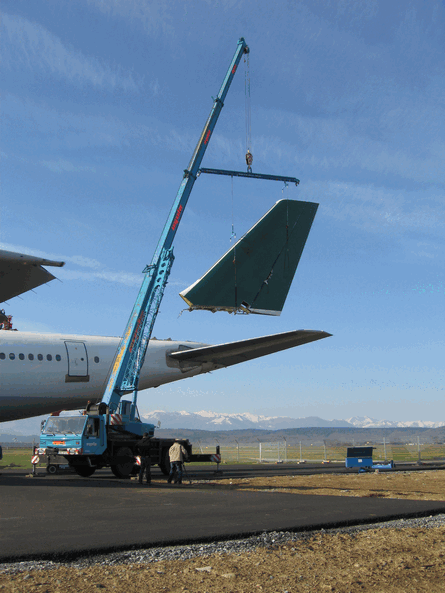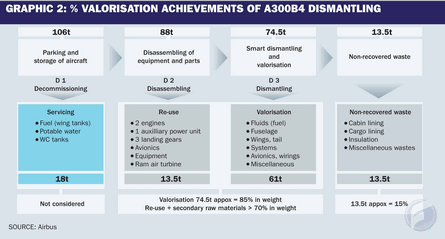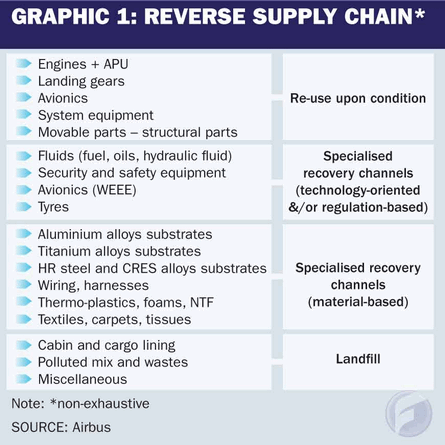Airbus is about to enter uncharted territory as it faces the downside of its sales surge a decade ago. Over the next 20 years, a quarter of the 6,000-plus airliners destined for the scrapheap will be Airbuses, and the company is in final throes of a project to ensure it is ready to manage its offspring's "end of life" in an organised and environmentally friendly manner.
 |
|---|
©Ben WangThe first of many- the oldest A320s are already facing the axe and increasing numbers will follow over the next 20 years |
"We are closing the loop of product life-cycle management," says Olivier Malavallon, Airbus project director environmental affairs, which is a task required by its ISO 14001 environmental management certification. The airframer has completed the first stage of an initiative to formulate best practice for the "smart dismantling" of airliner hulks, which will see the creation of an international network of approved aircraft breakers to handle the surge in Airbus retirements forecast to begin by the middle of the next decade.
While the oldest A320s are already beginning to come under the scrapman's axe, Airbus retirements will peak around 2016, with a second wave in around 2025. "We want to be ready for this," says Malavallon. He adds that by 2030, around half the annual airliner retirements are likely to be Airbus aircraft.
While end-of-life had not been an Airbus core business, Malavallon says that with around 1,500 Airbuses expected to be retired in the next 20 years, "the need for 'end-of-life' centres will become critical".
New Era
Another driver was the watershed that Airbus experienced in July last year when production of the A300/A310 ended. "We moved to a new era for Airbus - in-service support of a fleet where there are no longer new aircraft being manufactured," says Malavallon.
"We have put in place a specific organisation within customer services that wants to make sure we can supply our customers with parts and equipment at the best price and time. This means we are also looking at secondhand parts refurbished as spare parts."
 |
|---|
© AirbusWork to dismantle the 24-year-old A300B4 began in Tarbes in western France in February 2006 |
In March 2005, "Pamela" (Process for Advanced Management of End of Life of Aircraft) was launched as an aircraft dismantling demonstration project with support from the European Commission's "LIFE" initiative under the classification of "waste management, recycling and reduction of landfill".
Airbus participated in partnership with two EADS divisions (CCR - now Innovation Works - and Sogerma Services) as well as Paris-based waste management company Suez-Sita and Prefecture Hautes Pyrenees - a local government administration that has ensured the Pamela demonstration was fully compliant with all regulations.
 |
|---|
©AirbusAirbus spent a year taking the A300 apart to establish the best practice for dismantling. |
For the exercise a 24-year-old ex-Fly Air A300B4 (MSN194) was purchased and ferried to Tarbes airport in western France in February 2006 for dismantling.
The A300 parting-out exercise, which took a year, was used to evaluate current practices employed by aircraft breakers, and to examine ways of improving the process to increase the amount and quality of materials recovered.
Recovered Equipment
The target was to achieve unprecedented level of valorisation of aircraft materials (the amount that can be sold to a recovery channel, regardless of material purity) and to establish recommendations for improving tracking of parts and equipment recovered from scrapped aircraft.
"There are currently no guidelines or advice related to the end-of-life of aircraft. More and more we see wild destruction of aircraft, with specialist companies that go to an airfield, crunch the aircraft for non-ferrous metals and then leave the hulk," says Malavallon.
Current practices allow around 60% of the aircraft's weight to be recovered, and only 50% of this can be recycled, says Malavallon. "This means only 30% of the total is recycled."
The benefit of undertaking a more thorough, "smart dismantling" process is that up to 70-80% of the scrap by weight is recovered for reuse. And scrap metal recovered is of a higher grade, for example the recovered aluminium can be reused in aerospace, says Malavallon.
The recycling process also has further environmental benefits. Aluminium manufacturing is very energy-consuming as it requires electrolysis, says Malavallon, but when it is recovered for recycling "the re-fusion process saves almost 90% of the initial energy, so we have a double gain - preserving the raw material in the ground and saving energy".
The Pamela project broke down the dismantling process into three main steps:
Decommissioning (D1) is the process undertaken when aircraft are put into intended temporary storage, and will not prevent a return to service later. Processes include cleaning and decontamination, draining of tanks, and implementation of safety procedures.
Disassembling (D2) is the process that follows the decision to use the parked aircraft as a spares source, in compliance with airworthiness regulations. It comprises equipment and parts removal but does not exclude the possibility that the aircraft could eventually be restored to service.
Smart dismantling and valorisation (D3) is the dismantling process that begins once the irreversible decision is taken to turn the aircraft to waste. This stage includes the final draining of systems, removal of polluting and/or hazardous materials and finally the "deconstruction" of the aircraft.
No Turning Back
"Three quarters of aircraft entering D1 will return to service," says Malavallon. "But once the decision is taken to go to D3 waste it must be one way, you cannot turn back. Regulations require that parts are mutilated in such a way that they cannot be reused."
Once the deconstruction phase begins "you are no longer talking about an aircraft and parts, you are talking about materials", says Malavallon. "You are switching from the aerospace business to waste management. You have different containers of materials by category ready for shipping to their respective recovery channels: either recycling, valorisation or landfill."
 |
|---|
©AirbusThe project avoided "wild destruction" in an effort to find a smarter way to dismantle airliners |
To formulate the smart dismantling process, Airbus breaks down an aircraft into four categories: structure, cockpit/cabin/cargo, systems and powerplant. "We apply material filtering processes to these categories - metallics, composites, elastomers, fluids/gas, miscellaneous," says Malavallon. This enables the specialised recovery channels to be identified for each part of the aircraft. "We have to do reverse engineering or 'mapping' - what type of material, what amount and what location."
Reverse Supply Chain
To facilitate the recycling, a reverse supply chain is devised "to feed back to the aerospace business", says Malavallon. "We have to establish where the value is and how to maintain it as much as possible - if you can refurbish parts where it is safe and economically viable you will maximise its value, for example landing gear, engines and avionics."
Malavallon points out that aluminium is currently worth €2,200-2,400 ($3,400-3,700) per tonne, while titanium is worth €18,000-22,000 per tonne, depending on the grade.
While "specialised recovery channels" can be used to recycle other parts of the aircraft such as tyres, wiring harnesses and carpets (see graphic 1), there are some elements for which there is currently no viable recovery solution, says Malavallon:
|
|---|
"For example the cabin and cargo lining and polluted mix and wastes have to go to landfill today. This is not something we are happy with, but it is a matter of fact."
The recycling case study started with the A300B4 arriving in Tarbes weighing around 106t and after parts removal and dismantling ended with around 13.5t of non-recoverable waste (see graphic 2) that went to landfill. D1 servicing - the removal of fuel, potable water and waste tanks - eliminated around 18t, says Malavallon. The D2 removal of parts and equipment "retained by the seller" (engines, APU, landing gear etc) accounted for 13.5t.
 |
|---|
"In D3 we dismantled the aircraft in a smart and safe manner recovering 61t of material," says Malavallon.
Pamela bettered the recycling expectations, with 74.5t or 85% of the aircraft's weight at the start of D2 recovered in valorisation terms, and more than 70% in terms of reused parts and recycled secondary raw materials.
Just 15% of the aircraft's weight went to landfill, which represents a reduction by a factor of three over the 40-45% level achieved using current practices, says Malavallon. While the cost of using landfill is economically feasible - Airbus quotes a figure of €250-300 per tonne for the indefinite storage of dangerous materials such as asbestos - Malavallon says that "it is no longer just an economic parameter, there is also social pressure on the owner to be considered". Airbus continues to drive to reduce the landfill quota further.
Airbus took one year to dismantle the A300, evaluating 16 different scenarios to establish one optimised process, whereas the current practice for breaking up a similarly sized widebody takes two days. "Once the process is up and running, Airbus estimates that smart dismantling will take "one to one and half months", says Malavallon.
Two techniques were examined for the dismantling of the A300's wings, with the right wing's disassembly carried out by two people over a three-month period, while its left wing was scrapped in just 2h to establish the economic quality and valorisation results. "Dismantling costs will depend on the smart dismantling process selected," says Malavallon. An extensive analysis of the processes was undertaken using a tool devised for the car dismantling industry dubbed "chrono-analysis".
Secondary Raw Material
Malavallon says: "Typically this looks at what you are doing, with which tool, where, and with how many people for how long. You link to that the amount of material you can extract and its value in the market place." He points out that the value of the recycled secondary raw material will depend on the status of the London Metal Exchange (LME), which is the international benchmark for metal values. He explains that because the LME value of different grades of metal can vary over time, "in D3 you must have the flexibility to address the prevalent market conditions".
Having presented its final Pamela report to the European Union in January, Airbus is now "moving to implement an industrial solution" for the end-of-life dismantling that is expected to be completed by October, says Malavallon, who believes platforms in western Europe must be capable of disassembling a minimum of 13-15 aircraft a year to make them economically viable, growing progressively to a maximum 50 a year.
"We want to develop a labellised worldwide network of end-of-life centres, like we have for MRO, that complies with a set of regulations and requirements so we can offer a service and solution to the customer. These could be MRO companies or new organisations with access to storage locations and the capability to dismantle the aircraft in the proper manner."
Last year Airbus and five partners created the Tarbes Advanced Recycling and Maintenance Aircraft Company (Tarmac Aerosave). The partners include Snecma Services, Suez-Sita, Dubai spares trader TASC aviation, equipment manufacturer Equip'Aero and engineering specialist Aeroconseil. Its first dismantling facility at Tarbes airport is due to become operational in the second half of this year.
The responsibility for creating the list of requirements and developing the network lies with Airbus's customer services division, which "is beginning talks with potential contractors worldwide", he adds.
Another benefit of the exercise is that Airbus can feed the lessons learnt back into the design of future aircraft to help with the recycling. "This is 'reverse design', where we ask the design office to consider certain criteria when developing future aircraft," says Malavallon.
So Airbus has completed the proof-of-concept exercise and proved that the basic principles are sound. The European airframer's next challenge is to convince the industry that the business case for such smart dismantling is economically viable.
Source: Flight International
























